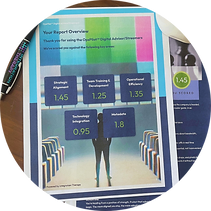Now There’s a Way to Measure an Elusive KPI: Revenue Leakage
- Rebecca Avery
- Sep 3
- 5 min read
Updated: Nov 11
I built OpsPilot™ because I wanted to give structure to something I have watched drain value from media companies for nearly two decades.
That same motivation is why I founded Integration Therapy: to help companies identify and contain the revenue they are already earning but not fully realizing. Over the years, I’ve had a uniquely broad vantage point. I’ve worked the entire supply chain of production, from early-stage development and writing, through technical operations, to global distribution. I’ve worked in startups where the priorities are speed and survival, and in major enterprises where complexity itself can be the greatest risk. I’ve sat inside small teams and giant organizations, and I’ve seen how both can leak revenue in different but familiar ways.
Layered onto that experience is academic grounding: I hold a master’s degree in Organizational Management and Leadership. That background has allowed me to put language and structure around patterns that I had been observing intuitively for years. It gives me not just the operational experience to diagnose the leaks, but also the management perspective to communicate what they mean at the organizational level.
The revenue leakage has always been there. What was missing was a way to measure it, much less communicate it to the people with the authority to influence the needed change.

The KPI That Eluded Measurement
Revenue in media organizations is tracked from many angles: top-line growth, churn, average revenue per user, ad yield, operating margins. These KPIs capture the financial and market-facing health of the enterprise.
What they don’t capture is how much of that revenue slips away inside the organization itself.
Leakage is not invisible. Some of it is loud: failed projects, overrun budgets, missed deadlines. Some of it is subtle: metadata inconsistencies, training gaps, misaligned strategies. The difficulty is not seeing the problems, it’s aggregating them into a coherent measure. Because leakage originates in so many places, it has resisted being captured as a single, reportable KPI.
This challenge is particularly acute in streaming media and broadcast companies. In these environments, technology, process, and strategy are closely intertwined. A small breakdown in one area can cascade into multiple others, making both detection and remediation far more complicated. And sometimes what looks like a single leakage source is actually distributed across several functions: a metadata error might originate in content operations, but its consequences are felt in ad sales, rights management, and downstream distribution. That cross-functional spread magnifies the impact and makes it harder to pinpoint where to intervene.
At the same time, the market itself is changing at accelerating speed. As business models evolve and consumer expectations shift, companies are under constant pressure to adapt. That pace of change compounds the complexity of operations and makes leakage both more likely and harder to control.
OpsPilot was designed to close that measurement gap.
Transparent by Design
OpsPilot is a free digital advisor that produces a Revenue Leakage Score in under five minutes, paired with recommendations. Unless a participant requests a PDF download, the process is completely anonymous.
This design is intentional: leaders can respond candidly, explore their results immediately, and move forward without hesitation.
The purpose is to provide a pragmatic diagnostic: a tool that highlights where leakage is happening, how severe it is, and what sequence of actions can contain it.

The Framework: Five Pillars of Profit Containment
To measure revenue leakage systematically, I organized its sources into five interdependent pillars:
Strategic Alignment: whether strategy and execution reinforce each other.
Operational Efficiency: whether workflows minimize waste and rework.
Metadata: whether content is findable, trackable, and monetizable through accurate and consistent data.
Team Training & Development: whether staff have the skills and confidence to keep pace with change.
Technology: whether systems are modern, integrated, and scalable rather than fragmented or obsolete.
Every leakage source I have encountered fits within this taxonomy. Together, the pillars transform a diffuse set of operational problems into something measurable.
The Methodology: From Pillars to Score
The framework becomes actionable through a structured methodology:
Source identification: mapping the top ten leakage sources across three archetypes of media companies (streamers, dual-purpose broadcasters, content vendors).
Indicator design: survey items aligned with measurable operational factors and visible symptoms.
Weighting: equal by default, adjustable when emphasis is needed.
Range calibration: defining mild, medium, and severe leakage within each 0–100 scale.
Composite scoring: aggregating across the pillars into a single Revenue Leakage Score.
Benchmarking: normalizing against data published by leading consultancies and research organizations.
This produces a diagnostic that functions like a professional benchmark, but can be completed in minutes.
Accuracy: Directional, Not Absolute
It is important to understand what the Revenue Leakage Score represents. It is not intended as a precise accounting entry. It is a directional diagnostic—a compass rather than a GPS.
In statistical terms, the model is heteroscedastic: as leakage scores increase, the variance around them also increases. Put simply, the higher the score, the less precise it becomes, but the urgancy is already quite high before the estimate drifts too far.
Compounding error: When multiple leakage sources interact, their effects multiply. Metadata failures plus outdated systems plus insufficient training do not simply add up; they amplify.
Ranges, not decimals: A score in the 70% range does not mean the leakage is 70.0%. It means the leakage is in that neighborhood, and the diagnostic shows which pillars drive it.
Why scores exceed 100%: Because leakage is compounding, systemic losses can surpass the “theoretical maximum” of any single factor. A score above 100% reflects that reality.
This trade-off is deliberate. At lower scores, precision matters most. At higher scores, urgency outweighs precision.
Internal vs. External Leakage
OpsPilot does not attempt to calculate piracy, cybersecurity risk, churn, or market downturns. These are external threats, important but already highly visible, and often beyond operational control.
Internal leakage is different. It is multi-sourced, consistently under-reported, and directly within a company’s power to address. That is why OpsPilot focuses here: because it surfaces problems leaders can act on immediately.
Why It Matters
Without a reliable way to measure revenue leakage, companies risk pouring resources into initiatives that treat symptoms rather than causes. It is one reason enterprise IT projects so often underperform. Studies have shown that nearly 80% of enterprise IT projects fail to meet their goals (Standish Group, 2015; McKinsey, 2012). Those outcomes are not simply execution failures. They are leakage events in misalignment, data gaps, training shortfalls, and technology misuse that were never quantified.
By measuring leakage, leaders can reframe their priorities. The question is no longer only how do we grow top-line revenue? It is also how much of our existing top-line are we losing internally, and how do we contain it?
Closing: From Elusive to Measurable
Revenue leakage has long been acknowledged in business. But in media, it has been elusive to measure, recognized in principle, yet resistant to aggregation because of its complexity, its cross-functional spread, and the accelerating pace of change.
OpsPilot makes it measurable. It provides a structured way to quantify leakage, identify its drivers, and act on them immediately.
This is not a replacement for existing KPIs. It is a complement: a tool that ensures growth strategies are not undermined by internal erosion.
For too long, revenue leakage has been treated as an unavoidable cost of doing business. It does not have to be. Measuring it is the first step toward containing it, and containment is the first step toward resilience in a volatile market.




.png)